Urban Resilience and Its Links to City Size: Evidence from the Yangtze River Economic Belt in China
Abstract
:1. Introduction
2. Conceptual Framework
2.1. Urban Resilience
2.2. Relationship between Urban Resilience and City Size
3. Materials and Methods
3.1. Study Area
3.2. Data Sources
3.3. Methods
3.3.1. Assessment of Urban Resilience
3.3.2. Calculation of City Size
3.3.3. Coupling Coordination Degree Model
4. Results
4.1. Analysis of Urban Resilience and Obstacle Factors
4.1.1. Spatial–Temporal Differentiation of Urban Resilience in YREB
4.1.2. Obstacle Factors of Urban Resilience
4.2. Variation in City Size from 2005 to 2020
4.3. Coupling Coordination Degree Analysis
4.3.1. Coupling Degree between City Size and Urban Resilience
4.3.2. Coupling Degree between City Size and Urban Resilience
4.4. Relationship between Key Obstacle Factors and City Size
5. Discussion
5.1. Dynamic Changes in Urban Resilience and Its Subdimensions
5.2. Insights of the Relationship between City Size and Urban Resilience
5.3. Major Factors Hindering the Urban Resilience in Different City Size
6. Conclusions
Author Contributions
Funding
Data Availability Statement
Conflicts of Interest
Appendix A
| Zone | Members | Characteristic |
|---|---|---|
| upstream | Chongqing Chengdu Zigong Panzhihua Luzhou Deyang Mianyang Guangyuan Suining Neijiang Leshan Nanchong Meishan Yibin Guang’an Dazhou Ya’an Bazhong Ziyang A’Bazhou Ganzizhou Liangshanzhou Kunming Qujing Lijiang Yuxi Zhaotong Baoshan Pu’Er Lincang Chuxiongzhou Dalizhou Dehongzhou Diqingzhou Honghezhou Nujiangzhou Wenshanzhou Sipsongpanna Guiyang Liupanshui Zunyi Anshun Tongren Bijie Qiannanzhou Qianxinanzhou Qiandongnanzhou | This region accounts for 60%, 55.4%, 48%, 33.2%, and 23.3% of the species, area, water resource, population, and GDP of the YREB, respectively. It is dominated by mountains and plateaus, with high mountains and deep valleys, and obvious topography. It has abundant water resources, hydropower resources, forest resources, and tourism resources. This region contains some of the most concentrated and serious geological disasters, such as landslides, mud–rock flows, and earthquakes, in China. |
| midstream | Nanchang Jiujiang Jingdezhen Shangrao Yingtan Fuzhou Yichun Xinyu Pingxiang Ji’An Ganzhou Wuhan Huangshi Xiangyang Jingzhou Yichang Shiyan Xiaogan Jingmen E’Zhou Huanggang Xianning Suizhou Enshizhou Changsha Zhuzhou Xiangtan Hengyang Shaoyang Yueyang Changde Zhangjiajie Yiyang Loudi Chengzhou Yongzhou Huaihua Xiangxizhou | This region covers the largest urban agglomeration in China, with its area, population, and GDP accounting for about 27.5%, 29.2%, and 24.3% of YREB, respectively. The terrain of this region is relatively flat, with plain, low mountains and hills. It has numerous rivers and lakes, rich in water resources and mineral resources. Flooding is one of the major natural threats testing the resilience of cities in this region. |
| downstream | Suzhou Wuxi Changzhou Zhenjiang Nanjing Nantong Yangzhou Taizhou Jiangyin Huai’An Suqian Xuzhou Lianyungang Zhoushan Hangzhou Jiaxing Wenzhou Ningbo Shaoxing Huzhou Lishui Taizhou Jinhua Quzhou Hefei Wuhu Bengbu Huainan Ma’Anshan Huaibei Tongling Anqing Huangshan Fuyang Suzhou Chuzhou Lu’An Xuancheng Chizhou Bozhou | This region account for 17.1%, 37.6%, and 52% of the area, population, and GDP of the YREB, respectively. This region is one of the flattest areas in China, with wide and deep rivers, abundant water resources, a dense population, and advanced science and technology. The main problems facing this area are water pollution and air pollution. |
Appendix B
| Year | SUP | Ranking | ||||
|---|---|---|---|---|---|---|
| 1 | 2 | 3 | 4 | 5 | ||
| 2005 | <1 million | X37 163.58 | X45 162.80 | X19 162.06 | X40 161.07 | X32 160.27 |
| 1–3 million | X37 182.88 | X40 180.87 | X45 177.45 | X44 177.17 | X19 176.64 | |
| 3–5 million | X37 28.62 | X33 27.11 | X40 26.16 | X12 24.93 | X19 20.95 | |
| 5–10 million | X37 15.57 | X33 14.28 | X40 14.25 | X45 14.05 | X20 7.69 | |
| ≥10 million | X26 7.16 | X20 7.16 | X12 7.16 | - | - | |
| 2010 | <1 million | X37 119.92 | X45 119.46 | X19 118.89 | X32 118.81 | X31 117.97 |
| 1–3 million | X37 206.57 | X40 204.89 | X19 204.23 | X32 198.40 | X31 191.40 | |
| 3–5 million | X37 41.71 | X40 40.35 | X45 39.74 | X19 34.02 | X32 32.76 | |
| 5–10 million | X45 24.69 | X12 24.08 | X40 24.66 | X37 23.87 | X20 18.22 | |
| ≥10 million | X20 9.53 | X39 8.40 | X8 8.37 | X12 8.15 | X33 5.89 | |
| 2015 | <1 million | X37 63.45 | X45 63.37 | X38 63.17 | X19 61.43 | X32 59.26 |
| 1–3 million | X37 231.94 | X45 230.38 | X40 230.37 | X19 227.22 | X32 214.12 | |
| 3–5 million | X37 56.52 | X12 56.03 | X40 55.54 | X45 55.46 | X38 54.67 | |
| 5–10 million | X12 34.71 | X45 33.17 | X38 32.53 | X37 31.61 | X40 30.54 | |
| ≥10 million | X30 11.66 | X26 11.42 | X12 9.24 | X40 6.56 | X38 6.43 | |
| 2020 | <1 million | X37 64.82 | X45 64.53 | X40 64.40 | X19 61.96 | X32 61.05 |
| 1–3 million | X40 223.34 | X37 222.80 | X45 222.70 | X19 207.45 | X32 202.21 | |
| 3–5 million | X37 62.59 | X40 62.37 | X45 61.58 | X44 60.87 | X19 53.75 | |
| 5–10 million | X40 33.80 | X45 32.69 | X37 31.96 | X44 29.14 | X19 25.24 | |
| ≥10 million | X20 15.68 | X26 13.83 | X37 12.61 | X40 12.57 | X45 12.32 | |
References
- Beck, U. Risk Society: Towards a New Modernity; Sage: London, UK, 1992. [Google Scholar]
- Huang, G.; Li, D.; Zhu, X.; Zhu, J. Influencing factors and their influencing mechanisms on urban resilience in China. Sustain. Cities Soc. 2021, 74, 103210. [Google Scholar] [CrossRef]
- Banai, R. Pandemic and the planning of resilient cities and regions. Cities 2020, 106, 102929. [Google Scholar] [CrossRef]
- Shamsuddin, S. Resilience resistance: The challenges and implications of urban resilience implementation. Cities 2020, 103, 102763. [Google Scholar] [CrossRef]
- Chen, J.; Guo, X.; Pan, H.; Zhong, S. What determines city’s resilience against epidemic outbreak: Evidence from China’s COVID-19 experience. Sustain. Cities Soc. 2021, 70, 102892. [Google Scholar]
- Meerow, S.; Newell, J.P. Urban resilience for whom, what, when, where, and why? Urban Geogr. 2019, 40, 309–329. [Google Scholar] [CrossRef]
- City Resilience Index. City Resilience Framework; The Rockefeller Foundation ARUP: New York, NY, USA, 2014; Volume 4, p. 928. [Google Scholar]
- Büyüközkan, G.; Ilıcak, Ö.; Feyzioğlu, O. A review of urban resilience literature. Sustain. Cities Soc. 2022, 77, 103579. [Google Scholar] [CrossRef]
- World Bank. Building Urban Resilience; Jha, A., Miner, T., Stanton-Geddes, Z., Eds.; World Bank: Washington, DC, USA, 2013. [Google Scholar]
- Van Putten, I.; Villanueva, C.; Cvitanovic, C. The Influence of community size and location on different dimensions of vulnerability: A case study of Australian coastal communities. Aust. Geogr. 2017, 48, 121–142. [Google Scholar] [CrossRef]
- Stier, A.J.; Berman, M.G.; Bettencourt, L.M.A. COVID-19 attack rate increases with city size. arXiv 2020, 2003, 10376. [Google Scholar]
- Hua, J.; Zhang, X.; Ren, C.; Shi, Y.; Lee, T.-C. Spatiotemporal assessment of extreme heat risk for high-density cities: A case study of Hong Kong from 2006 to 2016. Sustain. Cities Soc. 2021, 64, 102507. [Google Scholar]
- Capello, R.; Caragliu, A.; Fratesi, U. Spatial heterogeneity in the costs of the economic crisis in Europe: Are cities sources of regional resilience? J. Econ. Geogr. 2015, 15, 951–972. [Google Scholar] [CrossRef]
- Feng, X.; Lei, J.; Xiu, C.; Li, J.; Bai, L.; Zhong, Y. Analysis of Spatial Scale Effect on Urban Resilience: A Case Study of Shenyang, China. Chin. Geogr. Sci. 2020, 30, 1005–1021. [Google Scholar] [CrossRef]
- Hamidi, S.; Sabouri, S.; Ewing, R. Does Density Aggravate the COVID-19 Pandemic? J. Am. Plann. Assoc. 2020, 86, 495–509. [Google Scholar] [CrossRef]
- Earl, C.; Vietnam, R. Living with authoritarianism: Ho Chi Minh city during COVID-19 lockdown. City Soc. 2020, 32, 12306. [Google Scholar] [CrossRef]
- Chu, Z.; Cheng, M.; Song, M. What determines urban resilience against COVID-19: City size or governance capacity? Sustain. Cities Soc. 2021, 75, 103304. [Google Scholar] [CrossRef]
- Giddens, A. Les Conséquences de la Modernité [1990]; L’Harmattan: Paris, France, 1994. [Google Scholar]
- Lloyd. Lloyd’s City Risk Index 2015–2025. City Risk Executive Summary; Lloyd’s of London: London, UK, 2015. [Google Scholar]
- UN-Habitat. New Urban Agenda: Habitat III: Quito 17–20 October 2016; UN: Nairobi, Kenya, 2017; ISBN 978-92-1-132731-1. [Google Scholar]
- Godschalk, D.R. Urban Hazard Mitigation: Creating Resilient Cities. Nat. Hazards Rev. 2003, 4, 136–143. [Google Scholar] [CrossRef]
- Ahern, J. From fail-safe to safe-to-fail: Sustainability and resilience in the new urban world. Landsc. Urban Plan. 2011, 100, 341–343. [Google Scholar] [CrossRef]
- Meerow, S.; Newell, J.P.; Stults, M. Defining urban resilience: A review. Landsc. Urban Plan. 2016, 147, 38–49. [Google Scholar] [CrossRef]
- Pizzo, B. Problematizing resilience: Implications for planning theory and practice. Cities 2015, 43, 133–140. [Google Scholar] [CrossRef]
- Michel-Kerjan, E. We must build resilience into our communities. Nature 2015, 524, 389. [Google Scholar] [CrossRef]
- Birkmann, J.; Welle, T.; Solecki, W.; Lwasa, S.; Garschagen, M. Boost resilience of small and mid-sized cities. Nature 2016, 537, 605–608. [Google Scholar] [CrossRef] [PubMed]
- Du, M.; Zhang, X.; Wang, Y.; Tao, L.; Li, H. An operationalizing model for measuring urban resilience on land expansion. Habitat Int. 2020, 102, 102206. [Google Scholar] [CrossRef]
- Holling, C.S. Resilience and Stability of Ecological Systems. Annu. Rev. Ecol. Syst. 1973, 4, 1–23. [Google Scholar] [CrossRef]
- Bruneau, M.; Chang, S.E.; Eguchi, R.T.; Lee, G.C.; O’Rourke, T.D.; Reinhorn, A.M.; Shinozuka, M.; Tierney, K.; Wallace, W.A.; von Winterfeldt, D. A Framework to Quantitatively Assess and Enhance the Seismic Resilience of Communities. Earthq. Spectra 2003, 19, 733–752. [Google Scholar] [CrossRef]
- Lin, Y.; Peng, C.; Shu, J.; Zhai, W.; Cheng, J. Spatiotemporal characteristics and influencing factors of urban resilience efficiency in the Yangtze River Economic Belt, China. Environ. Sci. Pollut. Res. 2022, 29, 39807–39826. [Google Scholar] [CrossRef]
- Bettencourt, L.M.A.; Lobo, J.; Helbing, D.; Kuhnert, C.; West, G.B. Growth, innovation, scaling, and the pace of life in cities. Proc. Natl. Acad. Sci. USA 2007, 104, 7301–7306. [Google Scholar] [CrossRef]
- Lei, W.; Jiao, L.; Xu, G.; Zhou, Z. Urban Scaling in Rapidly Urbanising China. Urban Stud. 2022, 59, 1889–1908. [Google Scholar] [CrossRef]
- Lee, V.J.; Aguilera, X.; Heymann, D.; Wilder-Smith, A. Lancet Infectious Diseases Commission Preparedness for Emerging Epidemic Threats: A Lancet Infectious Diseases Commission. Lancet Infect. Dis. 2020, 20, 17–19. [Google Scholar] [CrossRef]
- Sharifi, A. Urban form resilience: A meso-scale analysis. Cities 2019, 93, 238–252. [Google Scholar] [CrossRef]
- Hu, M.; Roberts, J.D.; Azevedo, G.P.; Milner, D. The role of built and social environmental factors in COVID-19 transmission: A look at America’s capital city. Sustain. Cities Soc. 2021, 65, 102580. [Google Scholar] [CrossRef]
- Zhang, X.; Liu, L.; Zhao, T.; Gao, Y.; Chen, X.; Mi, J. GISD30: Global 30 m impervious-surface dynamic dataset from 1985 to 2020 using time-series Landsat imagery on the Google Earth Engine platform. Earth Syst. Sci. Data 2022, 14, 1831–1856. [Google Scholar] [CrossRef]
- Manyena, S.B. The concept of resilience revisited. Disasters 2006, 30, 434–450. [Google Scholar] [CrossRef] [PubMed]
- Kim, S.; Rowe, P.G. Are master plans effective in limiting development in China’s disaster-prone areas? Landsc. Urban Plan. 2013, 111, 79–90. [Google Scholar] [CrossRef]
- Moser, S.; Meerow, S.; Arnott, J.; Jack-Scott, E. The Turbulent World of Resilience: Interpretations and Themes for Transdisciplinary Dialogue. Clim. Change 2019, 153, 21–40. [Google Scholar] [CrossRef]
- Nasiri, N.A.; Al-Awadhi, T.; Hereher, M.; Ahsan, R.; AlRubkhi, A.G. Changing urban ecology a challenge for coastal urban resilience: A study on muscat. Environ. Urban. ASIA 2020, 11, 10–28. [Google Scholar] [CrossRef]
- Zhao, R.; Fang, C.; Liu, H. Progress and prospect of urban resilience research. Prog. Geogr. 2020, 39, 1717–1731. (In Chinese) [Google Scholar] [CrossRef]
- Jha, A.K.; Miner, T.W.; Stanton-Geddes, Z. Building Urban Resilience: Principles, Tools, and Practice; World Bank and Australian Aid: Washington, DC, USA, 2013. [Google Scholar]
- Lu, H.; Lu, X.; Jiao, L.; Zhang, Y. Evaluating Urban Agglomeration Resilience to Disaster in the Yangtze Delta City Group in China. Sustain. Cities Soc. 2022, 76, 103464. [Google Scholar] [CrossRef]
- Wang, L.; Liu, H. Comprehensive evaluation of regional resources and environmental carrying capacity using a PS-DR-DP theoretical model. J. Geogr. Sci. 2019, 29, 363–376. [Google Scholar] [CrossRef]
- Fan, Y.; Fang, C. Evolution process and obstacle factors of ecological security in western China, a case study of Qinghai province. Ecol. Indic. 2020, 117, 106659. [Google Scholar] [CrossRef]
- Kuang, W. Mapping global impervious surface area and green space within urban environments. Sci. China Earth Sci. 2019, 62, 1591–1606. [Google Scholar] [CrossRef]
- Cottineau, C. MetaZipf. A dynamic meta-analysis of city size distributions. PLoS ONE 2017, 12, e0183919. [Google Scholar] [CrossRef]
- Li, Q.; Zhao, Y.; Li, S.; Zhang, L. Spatial-temporal characteristics of the coupling coordination of social security and economic development in China during 2002–2018. Reg. Sustain. 2021, 2, 116–129. [Google Scholar] [CrossRef]
- Yang, X.; Zhang, F.; Xiao, Y.; An, Y.; Jiang, C.; Tan, H.; Gong, G. Coupling and interaction between tourism eco-efficiency and new urbanization in the Yangtze River Economic Belt: Based on the perspective of uncoupling coordination. Environ. Dev. Sustain. 2022, 25, 13171–13197. [Google Scholar] [CrossRef]
- Bai, L.M.; Xiu, C.L.; Feng, X.H.; Mei, D.W.; Wei, Y. A comprehensive assessment of urban resilience in China and its spatial and temporal variation characteristics. World Reg. Stud. 2019, 28, 77–87. [Google Scholar]
- Zhao, R.; Fang, C.; Liu, J.; Zhang, L. The evaluation and obstacle analysis of urban resilience from the multidimensional perspective in Chinese cities. Sustain. Cities Soc. 2022, 86, 104160. [Google Scholar] [CrossRef]
- Jiang, J.; Zhu, S.; Wang, W.; Li, Y.; Li, N. Coupling coordination between new urbanization and carbon emissions in China. Sci. Total Environ. 2022, 850, 158076. [Google Scholar] [CrossRef]
- Deng, X.; Liang, L.; Wu, F.; Wang, Z.; He, S. A review of the balance of regional development in China from the perspective of development geography. J. Geogr. Sci. 2022, 32, 3–22. [Google Scholar] [CrossRef]
- Xiao, Y.; Zhong, J.-L.; Zhang, Q.-F.; Xiang, X.; Huang, H. Exploring the coupling coordination and key factors between urbanization and land use efficiency in ecologically sensitive areas: A case study of the Loess Plateau, China. Sustain. Cities Soc. 2022, 86, 104148. [Google Scholar] [CrossRef]
- Feofilovs, M.; Romagnoli, F. Dynamic assessment of urban resilience to natural hazards. Int. J. Disaster Risk Reduct. 2021, 62, 102328. [Google Scholar] [CrossRef]
- Mou, Y.; Luo, Y.; Su, Z.; Wang, J.; Liu, T. Evaluating the dynamic sustainability and resilience of a hybrid urban system: Case of Chengdu, China. J. Clean. Prod. 2021, 291, 125719. [Google Scholar] [CrossRef]
- Zhou, B.-B.; Aggarwal, R.; Wu, J.; Lv, L. Urbanization-associated farmland loss: A macro-micro comparative study in China. Land Use Policy 2021, 101, 105228. [Google Scholar] [CrossRef]


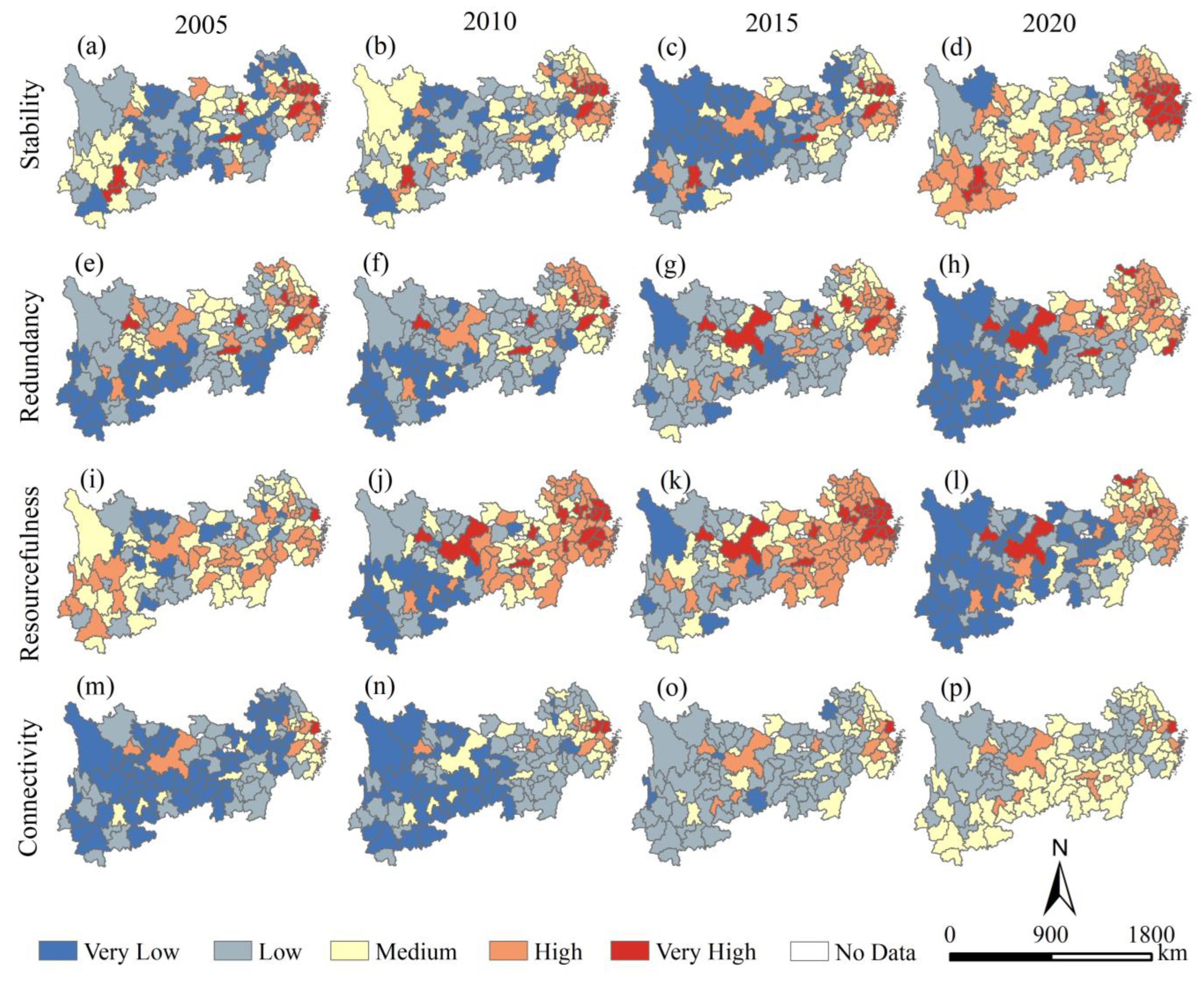
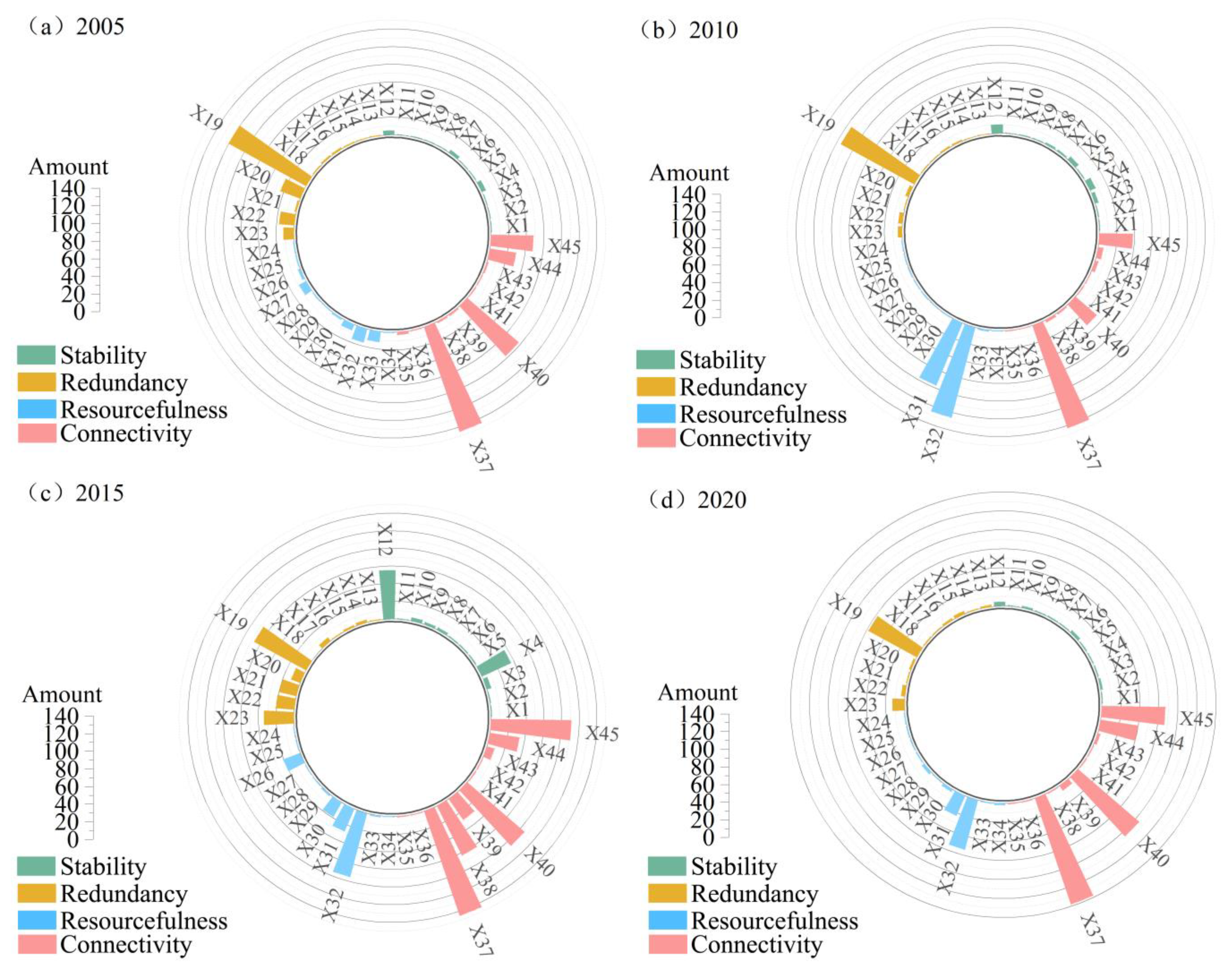
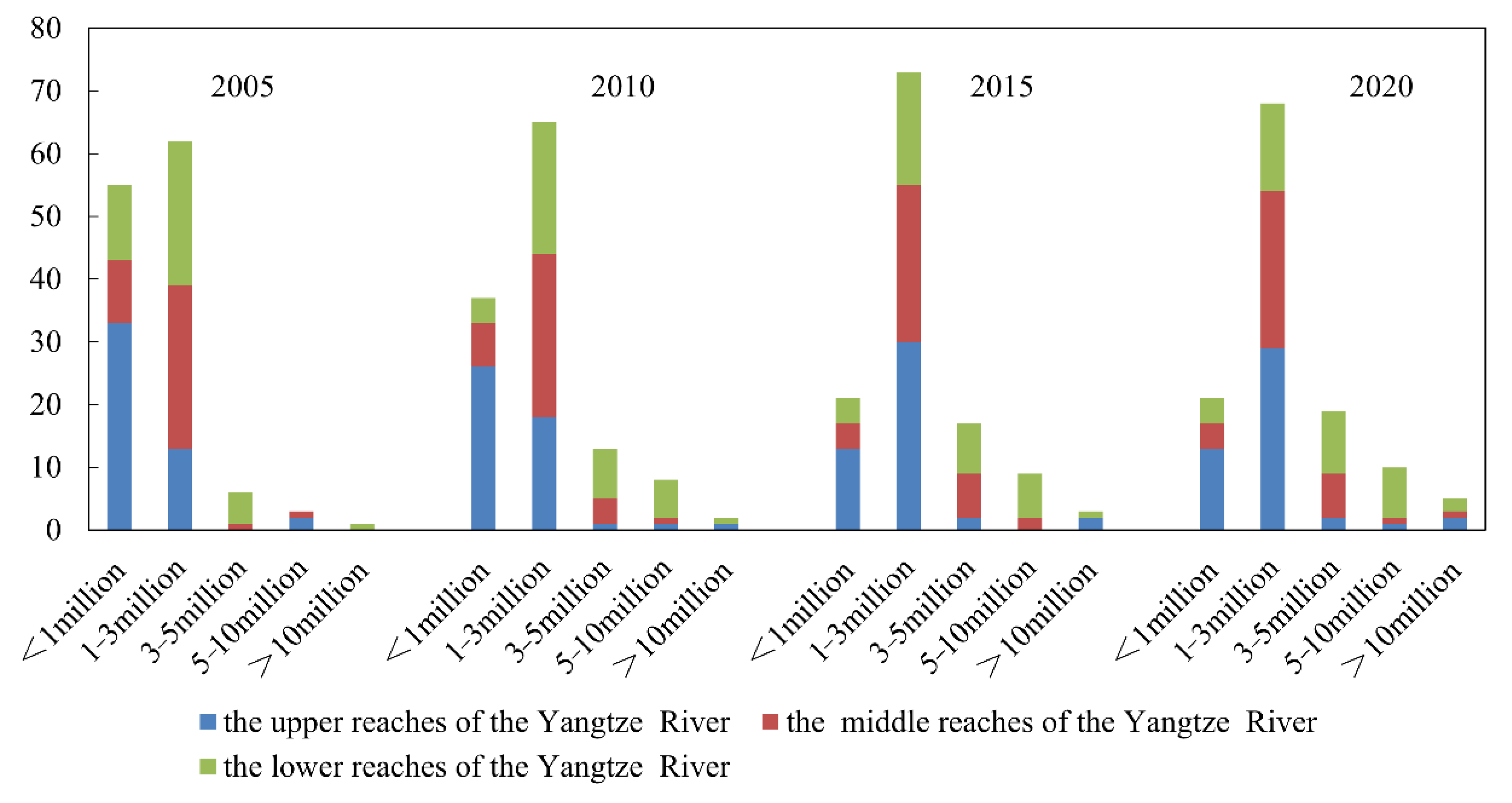

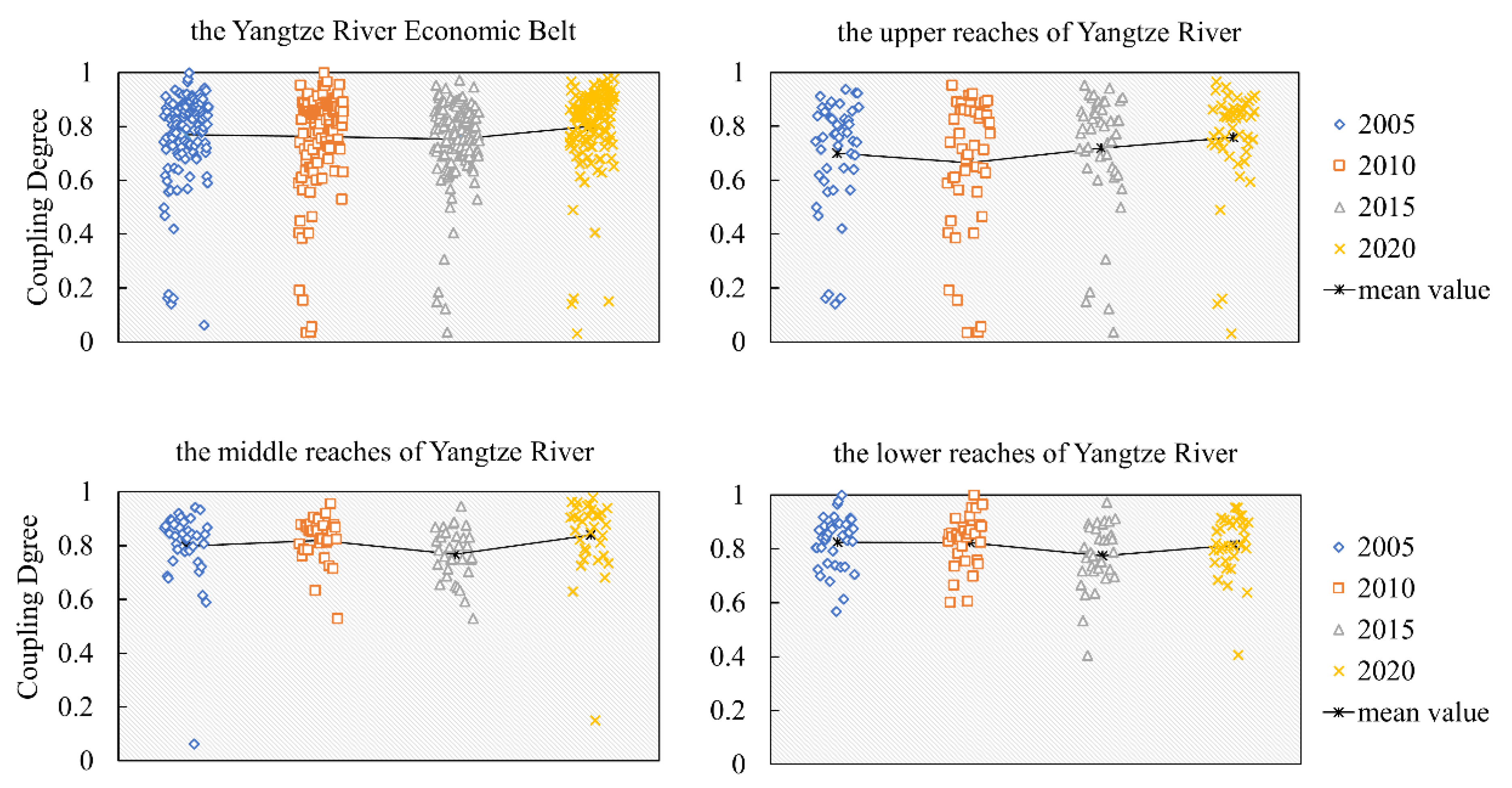

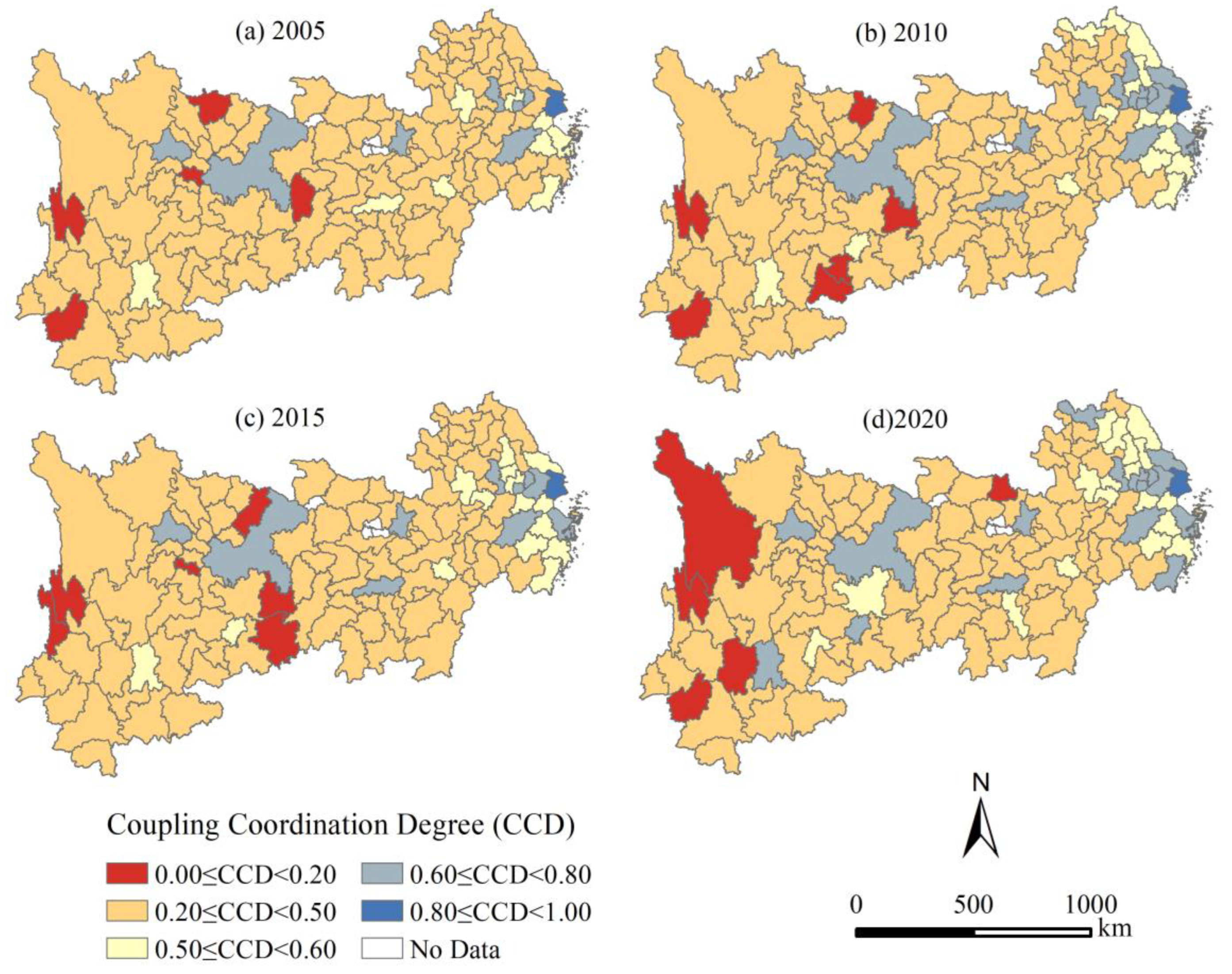
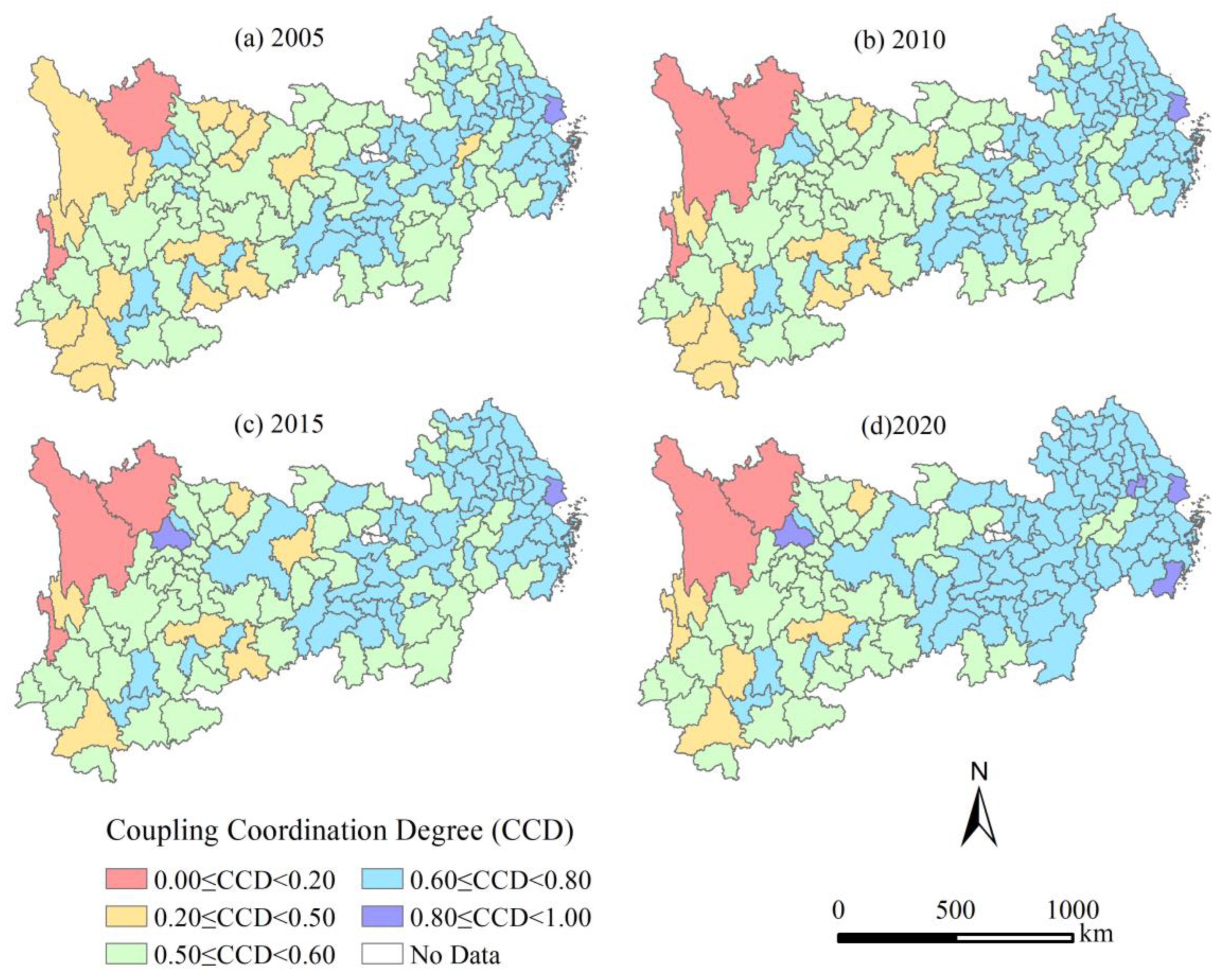
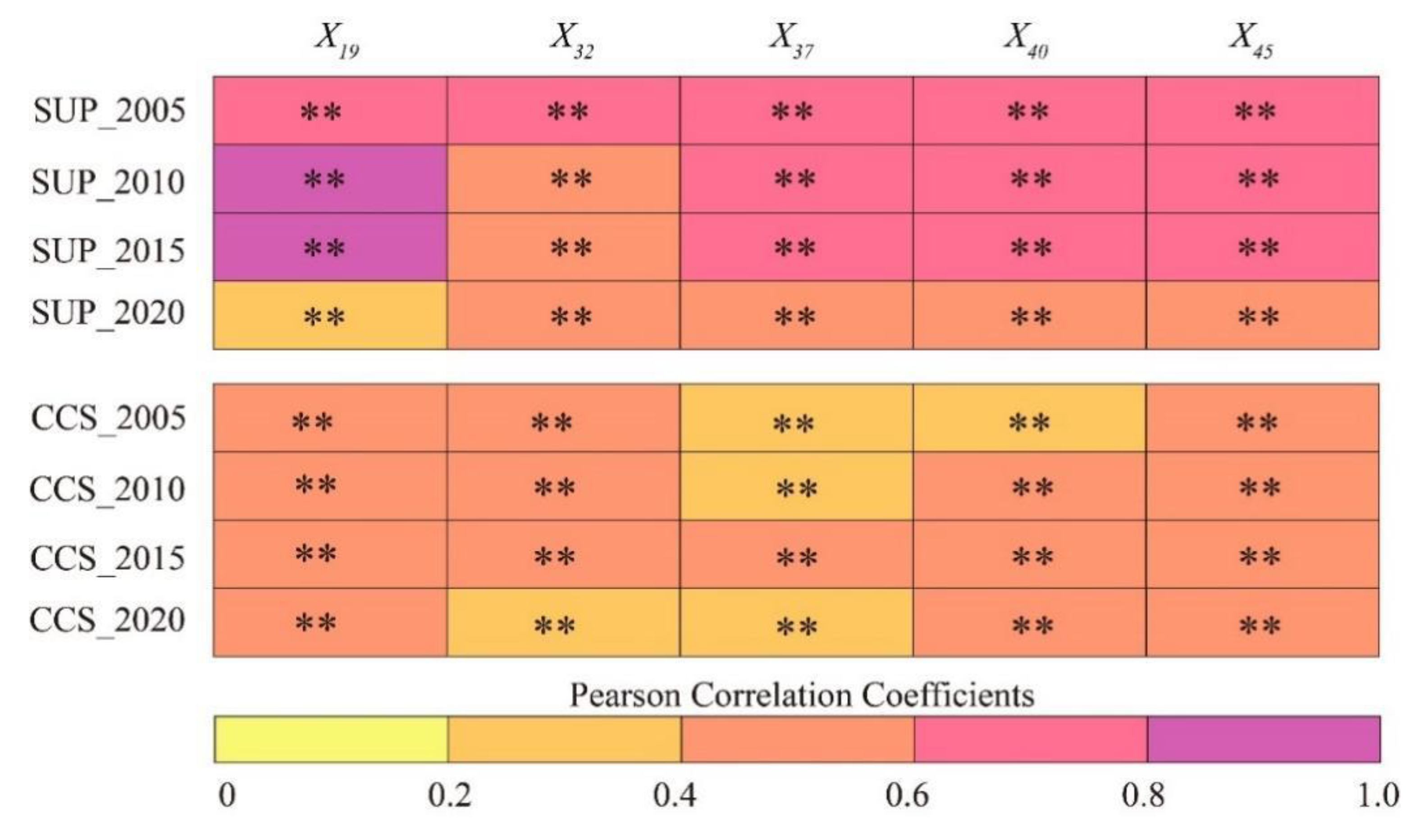
| Dimension of Urban Resilience | Index | Connotation of Indicators | Direction | ID |
|---|---|---|---|---|
| Stability | GDP per capita | Economic growth | + | X1 |
| Disposable income per capita | Residents’ resilience | + | X2 | |
| Proportion of fiscal revenue to GDP | Economic growth | + | X3 | |
| Total urban water supply | Subsistence resources | + | X4 | |
| Urban registered unemployment rate | Social employment pressure | − | X5 | |
| Number of beds in health care facilities per 10,000 Number of doctors per 10,000 people | Medical and health care | + | X6 | |
| + | X7 | |||
| Urban road area per capita | Road traffic | + | X8 | |
| Density of drainage pipes in built-up areas | Infrastructure | + | X9 | |
| Days of good air quality | Survival environment | + | X10 | |
| Assets and liabilities ratio of industrial enterprises above the scale | Market risk | − | X11 | |
| Energy self-sufficiency rate | Energy security | + | X12 | |
| Redundancy | Foreign trade dependence | Market dynamics | − | X13 |
| Industrialization rate | Industrial development level | + | X14 | |
| Urban basic pension coverage | Resident health and pension coverage | + | X15 | |
| Urban basic medical insurance coverage | + | X16 | ||
| Total fixed asset investment | Economic growth | + | X17 | |
| Green space per capita | Disaster prevention space | + | X18 | |
| Volume of domestic air routes | Air traffic | + | X19 | |
| Proportion of non-fossil fuel power generation | Green energy | + | X20 | |
| Number of books in public libraries per 10,000 | Intellectual resources | + | X21 | |
| Number of students enrolled in general higher education institutions | + | X22 | ||
| Number of general higher education institutions | + | X23 | ||
| Resourcefulness | Fiscal self-sufficiency rate | Economic dynamism | + | X24 |
| GDP growth rate | + | X25 | ||
| Natural population growth rate | Population structure | + | X26 | |
| Energy consumption per unit of GDP | Energy use efficiency | − | X27 | |
| Growth rate of social electricity consumption | High-quality development | + | X28 | |
| Index of advanced industrial structure | Industry and innovation | + | X29 | |
| Growth rate of total factor productivity | + | X30 | ||
| Number of invention patents per 10,000 | + | X31 | ||
| Number of granted invention patents per 10,000 | + | X32 | ||
| Proportion of expenditure on science and technology to fiscal expenditure | Innovation investment | + | X33 | |
| Proportion of expenditure on education to fiscal expenditure | + | X34 | ||
| Connectivity | Number of Internet broadband subscribers per 10,000 | Communication connectivity | + | X35 |
| Number of mobile phones per 10,000 | + | X36 | ||
| Number of Fortune 500 companies headquartered in the region | Location connectivity | + | X37 | |
| Freight traffic | + | X38 | ||
| Passenger traffic | + | X39 | ||
| International tourism revenue | Social connectivity | + | X40 | |
| Proportion of mobile population | Openness of the economy | + | X41 | |
| Foreign trade contribution | + | X42 | ||
| Foreign economic contribution | + | X43 | ||
| Amount of actual foreign investment utilized in the current year | + | X44 | ||
| Number of contracts signed by foreign-invested enterprises | + | X45 |
Disclaimer/Publisher’s Note: The statements, opinions and data contained in all publications are solely those of the individual author(s) and contributor(s) and not of MDPI and/or the editor(s). MDPI and/or the editor(s) disclaim responsibility for any injury to people or property resulting from any ideas, methods, instructions or products referred to in the content. |
© 2023 by the authors. Licensee MDPI, Basel, Switzerland. This article is an open access article distributed under the terms and conditions of the Creative Commons Attribution (CC BY) license (https://creativecommons.org/licenses/by/4.0/).
Share and Cite
Wang, L.; Li, J.; Lv, L. Urban Resilience and Its Links to City Size: Evidence from the Yangtze River Economic Belt in China. Land 2023, 12, 2131. https://doi.org/10.3390/land12122131
Wang L, Li J, Lv L. Urban Resilience and Its Links to City Size: Evidence from the Yangtze River Economic Belt in China. Land. 2023; 12(12):2131. https://doi.org/10.3390/land12122131
Chicago/Turabian StyleWang, Liang, Jingye Li, and Ligang Lv. 2023. "Urban Resilience and Its Links to City Size: Evidence from the Yangtze River Economic Belt in China" Land 12, no. 12: 2131. https://doi.org/10.3390/land12122131
APA StyleWang, L., Li, J., & Lv, L. (2023). Urban Resilience and Its Links to City Size: Evidence from the Yangtze River Economic Belt in China. Land, 12(12), 2131. https://doi.org/10.3390/land12122131








